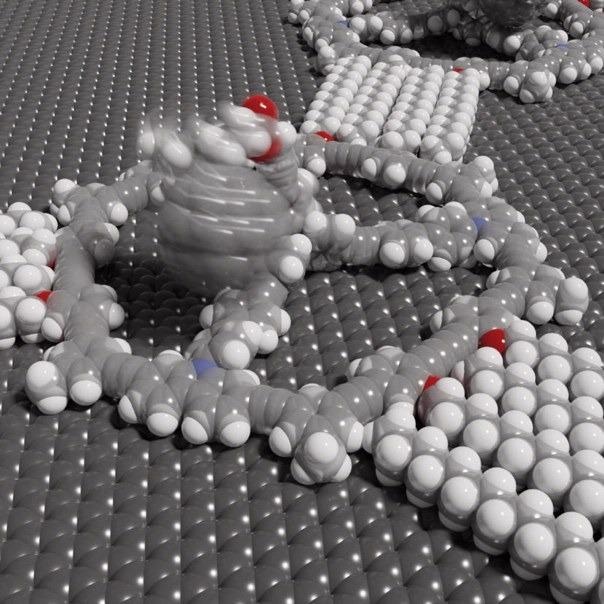Scientists at the University of Bonn have designed a molecular structure that can encompass graphite surfaces with a sea of miniature flagged "flagpoles". The coating’s properties are extremely variable. It may provide the foundation for the creation of new catalysts. The compounds may also be ideal for determining the nanomechanical properties of proteins.
 Model of a molecular Mercedes star-shaped molecule. The flagpole on top of it has a fullerene attached to it, the movement of which is also visualized here using a smudge effect. The model is also shown on the cover of the current issue of Angewandte Chemie. (Image Credit: © Joshua Bahr/Uni Bonn).
Model of a molecular Mercedes star-shaped molecule. The flagpole on top of it has a fullerene attached to it, the movement of which is also visualized here using a smudge effect. The model is also shown on the cover of the current issue of Angewandte Chemie. (Image Credit: © Joshua Bahr/Uni Bonn).
The results were reported online in advance in the journal "Angewandte Chemie". At present, the print edition has also been published, which showcases a part of the sea of flags as the cover image.
The standard building block of the surface covering is a big molecular ring. It is stabilized on the inside by spokes and thus bears a definite similarity to a Mercedes star. Furthermore, the ring consists of three little arms that orient outward.
Each arm can grab the arm of the subsequent ring. This allows the molecules to join together to form a massive sheet-like tissue without any external intervention. For this, it is adequate to dip a portion of graphite (which is the material that pencil leads, for example, are composed of) into a solution of these rings. Like magic, these then encompass the graphite surface with a net-like structure quite quickly.
The net’s mesh size can be precisely modified by altering the length of the arms. The real significance of the coating, however, lies in another alteration option.
We can attach tiny poles of different lengths to the center of the rings. We can then, in turn, attach other molecules to them, like flags to a flagpole.
Prof. Dr. Sigurd Höger, Kekulé Institute for Organic Chemistry and Biochemistry, University of Bonn
Prof. Dr. Sigurd Höger headed the study along with Dr. Stefan-Sven Jester (also Kekulé Institute) and Prof. Dr. Stefan Grimme of the Mulliken Center for Theoretical Chemistry.
A Miniature Sea of Flags
The distances between the poles are quite large, enabling even very bulky molecules to be stuck to their tips without crossing each other's way. On the one hand, they are then held in position by the poles, and on the other hand, they are unrestricted to move like a flag in the wind. Furthermore, they are easily available to substances in the solution and can react with them.
This may allow novel catalysts to be realized. Potentially, this will enable chemical reactions that were previously unfeasible or only possible with great effort.
Prof. Dr. Sigurd Höger, Kekulé Institute for Organic Chemistry and Biochemistry, University of Bonn
Any molecules can, in theory, be stuck to the tips of the flagpoles. In the future, this should also enable, for example, the measurement of the nanomechanical properties of proteins. To achieve this, the protein molecule would be kept in place by the flagpole and then pulled apart with a sort of "gripper arm".
Proteins consist of long filaments, but most of them are folded into compact sphere, which gives them their characteristic shape. The forces at work in the formation of the latter might be more accurately determined by such experiments.
Prof. Dr. Sigurd Höger, Kekulé Institute for Organic Chemistry and Biochemistry, University of Bonn
In Dr. Jester's laboratory, the molecules formed by Höger and his partners were placed on graphite and analyzed with a scanning tunneling microscope. Furthermore, using a computer, they replicated the surface patterns of the flag molecules.
"This enabled us to show that the molecules actually arrange themselves and behave exactly as predicted by our concepts and the theory," explains Jester, who, like Höger and Grimme, is a member of the Transdisciplinary Research Area "Building Blocks of Matter and Fundamental Interactions" (TRA Matter) at the University of Bonn.
Mimicking the dynamics of such huge and complex molecules necessitates massive computational resources. In the last few years, Prof. Grimme's team has formulated advanced approaches that make this feasible.
"We can use these methods, for example, to distinguish between flexibly and rigidly tethered molecules in the simulation and to predict their behavior," Grimme explains.
Among other molecules, the Bonn researchers stuck a structure resembling a football to the flagpoles, a so-called fullerene. It was able to hang unrestricted around the top of each mast kept in place by a sort of nano-cord.
"We can actually see this movement of the fullerenes, predicted by computer simulations, in our scanning tunneling microscope images," Jester says.
This is because the images of the molecular footballs are not sharp, but hazy: Quite like taking pictures of a real ball on a string swinging to and fro in the wind in low light. Tightly attached reference molecules, on the other hand, are plainly visible in the scanning tunneling microscope images.
Journal Reference:
Poluektov, G., et al. (2021) Supramolecular Nanopatterns of Molecular Spoked Wheels with Orthogonal Pillars: The Observation of a Fullerene Haze. Angewandte Chemie. doi.org/10.1002/anie.202111869.